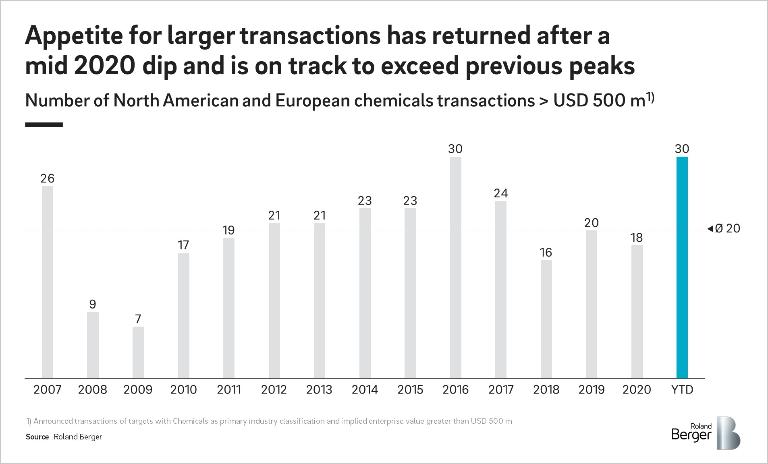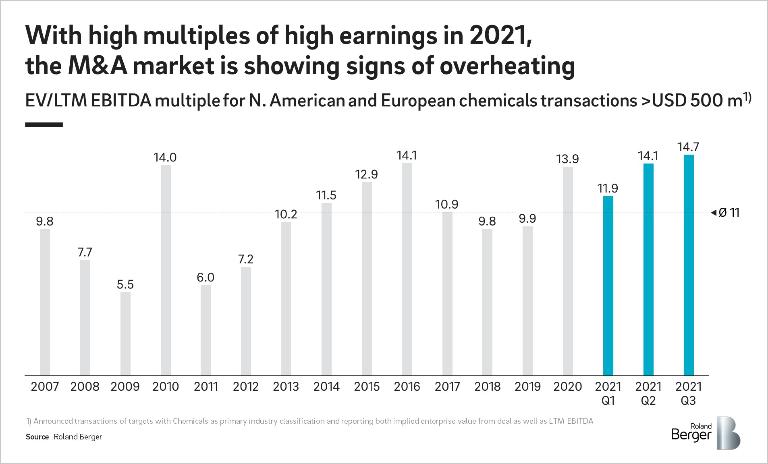

Chemicals M&A: Paving the Way for Long Term Deal Success
The past few months have seen unprecedented M&A activity in chemicals in North America and Europe. This activity has been driven by the concurrence of abundant capital injected into the industry and a 'new normal' COVID-impacted environment in which companies have rethought their portfolio strategies to align with a new world order. In this seller’s market, good deals can be done but success requires preparation. An understanding of changing industry dynamics, along with a unified strategic vision, can pave the way for long-term deal success.
Why Deal Activity Is Hot Right Now
Financially speaking, after the global economy started 2020 strong, COVID froze economic activity around the world. Credit markets shut down and uncertainty snowballed. Companies sat on cash for months and fund managers like private equity firms and hedge funds accumulated an unprecedented amount of dry powder: by the end of 2020, over USD 2 trillion dollars was committed to private equity for acquisitions. When the economy stabilized in Q3 of 2020, a sense of renewed optimism spread as governments injected billions of dollars into their economies on both sides of the Atlantic. This massive injection restored confidence in investment activity, unleashing capital markets and enabling M&A activity across the entire economy. In the chemicals industry, M&A activity jumped back to pre-COVID levels in early 2021, within six months of the Q2 2020 dip, much faster than it did after the 2008 financial crisis for example.
Strategically speaking, COVID shifted corporate priorities in chemicals, spurring the need to align portfolios with the post-COVID reality. First, COVID drove increased environmental awareness and concern, pushing companies to develop or sharpen greener visions. As city residents saw empty streets and cleaner skies while scientists documented sharp cuts to greenhouse gas emissions, the corporate world experienced an acceleration of sustainability’s journey to the forefront of boardrooms that drove M&A in green areas like hydrogen, renewable energy, or recycling related chemicals and exits from businesses seen as less sustainable (e.g. hazardous chemistries).
Second, the COVID and emerging post-COVID environment drove significant performance differences across chemicals industry segments. For example, businesses exposed to the food industry did well: ingredients like flavors, preservatives, and antimicrobials that support grocery store shopping and at-home dining experienced much improved financial performance. In contrast, other segments like oil & gas, mining, or heavy industry underperformed, as COVID drove a slowdown in the underlying activity. These differences in performance were a significant driver of portfolio management activity: many companies took decisive action to reduce overexposure to unattractive segments or double down on attractive ones.
Lastly, COVID accelerated a pre-existing quest for increased customer-centricity. Many chemicals companies, particularly in the specialty space, had already been seeking to expand their product and service portfolios to increase their collaboration with, and influence over, key customers. With significant volatility during COVID, and in the face of seemingly more frequent unexpected crises like COVID, customer-centricity has been seen as a way to achieve a more resilient business model. For example, an adhesive supplier focused on one adhesive chemistry increased its M&A spending to acquire several complementary adhesives technologies and evolve from a product-centric model to a more customer-focused model. The additional chemistries enabled that transition by providing new ways of solving customer problems. The apparent high price for these acquisitions was justified by the significant synergy potential.
As a result of these trends, chemicals M&A activity is at an all-time high. For example, as we write this article, the number of deals above USD 500 m exceeds already previous peaks (reference chart 1). Valuations are also high by historical standards: recent transaction multiples - based on enterprise values divided by last twelve months’ earnings before interest, taxes, depreciation and amortization (EBITDA) - are 2-3 turns above their historical average despite being based on strong earnings (reference chart 2). With these high multiples of high earnings, the chemicals M&A market is overheating. And with continued portfolio shifts at chemicals companies and fundraising by private equity firms, it shows no signs of slowing down.
What Companies in a Deal-Making Mood Should Consider
Now is a good time to sell. However, sellers need to be ready to deal with buyers that are increasingly leery of overpaying in a hot market environment. On the other side of the table, prospective buyers need not be dissuaded by high multiples. There are still ways to execute highly attractive acquisitions in this environment. The key to success for both sides is to be well prepared. Below are our key recommendations:
For buyers:
- Be deliberate: maintain and prioritize deal opportunities that are uniquely suited to your capabilities
- Make sure you know the businesses you are pursuing
- Pursue pre-due diligence work on priority targets
- Have a clear strategic rationale that is distinct from the synergy assessment
- Be disciplined about your willingness to pay - beware of the “winners’ curse” in competitive auctions
For sellers:
- Identify high-value owners of your business before starting the process and make sure they participate
- Be clear on your business model, market and competitive position, and what differentiates it from direct competitors
- Provide transparency on key assumptions supporting your expected business performance - in particular pricing and growth in post-COVID environment
- Include a description of value creation opportunities that high-value owners could pursue





